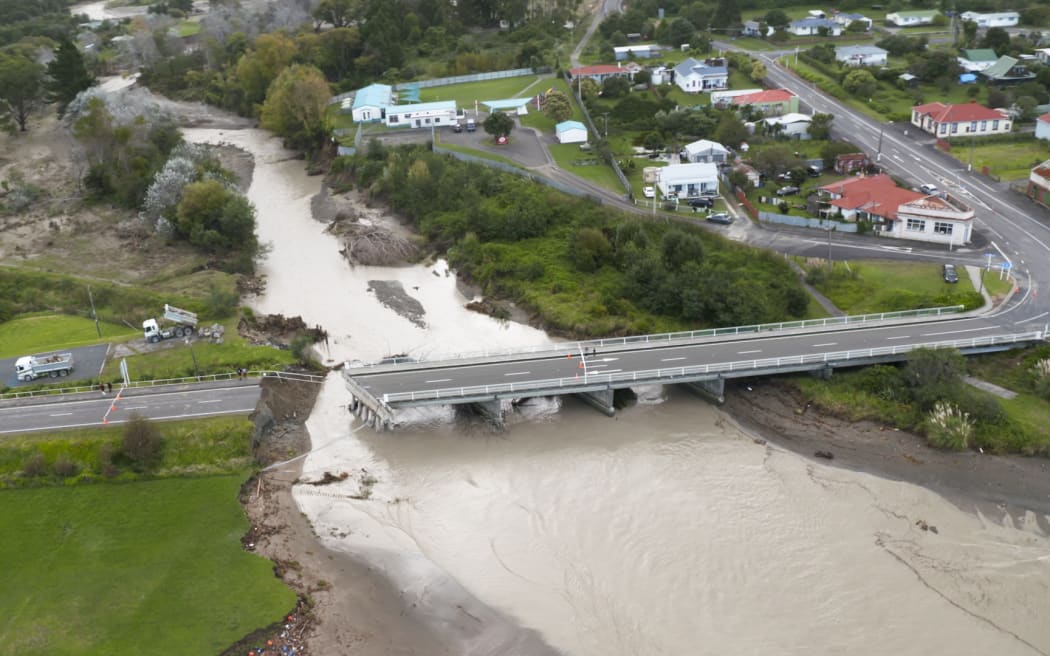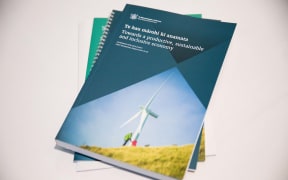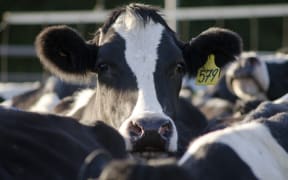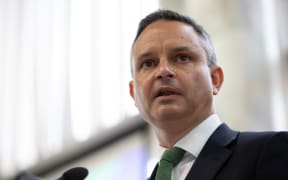There has been mixed reaction from Māori to the government's Emissions Reduction Plan with some arguing there are still gaps missing that the report does not address.

In March 2022, a section of the bridge in Tokomaru Bay was wiped out by flood water, bisecting the town alongside State Highway 35. Photo: RNZ / Angus Dreaver
Hinemaurea Marae in Tairāwhiti is no stranger to the impacts of climate change.
Marae chairperson Zak Horomia said although there was a flood bank that protected the East Coast marae, it was having to cope with more severe storms more often.
"The amount of rain we're getting now, back in the day we got it in two months or even two and a half months. We're getting it all in one night, and that water and the rain there fills up inside the marae. No water gets in, but it's just the amount of rain that we have, and it's like a pool inside the compound"
From the $2.9 billion emissions reduction plan, $35.4 million will go towards supporting a transition for farmers, growers and whenua Māori.
The report has a chapter called Empowering Māori, which includes establishing a platform for Māori climate change action.
Climate Change Minister James Shaw said the government would work alongside Māori to ensure everyone benefited.
"There's been a long history of the crown saying we want to work with Māori and here Māori are the ways we want you to work with us and creating those structures and systems without any real kind of level of co-design. We've kind of heard that critique of that approach and so what we've said is that the first stage here is that we will be going through a co-design stage with Māori."
Indigenous rights advocate Kera Sherwood O'Regan said it was encouraging to see the government recognising it needed to work with Māori.
"I think some of the promising aspects we're seeing, recognition that there needs to be capacity building on both sides so actually that the Crown does really need to be learning from Māori leadership on climate change and in this space. As well as capacity building for Māori communities."
Under the plan, $569m will be spent on helping low and middle-income families get rid of old cars and invest in carbon-free ones.
But Horomia said electric vehicles were not feasible in rural communities.
"They've got to get to work, people need to live. A lot of wagons are loaded. There's three or four in a wagon going to work. Probably about 300 or 400 in this region of four by fours with people going to work on. How are they going to stop all that? Electric cars can't get in the bush."
Te Pati Māori is not on board either, arguing the emissions reduction plan does not do enough to tackle pollution from agriculture.
In a social media post, the party tweeted: "Labour and the Greens' Emissions Reduction Plan lacks the ambition needed to meet international climate targets. They have now gone beyond giving a free pass to agriculture, now they are subsidising their inaction on methane to the tune of $710m."
From the $710m spent on the agriculture and forestry sector, $339m will go towards accelerating technology and establishing a Centre for Climate Action on Agricultural Emissions.
Climate Change Iwi Leaders Group chair Mike Smith agreed with the Māori Party.
"While at the same time receiving something I think like $400m worth of taxpayers money to kind of look at developing a way that it can be brought into the ETS I think is just not on. To allow agriculture to get off the hook once again just throws into question whether or not this is an emissions reduction plan fit for purpose."
While he believed there were good parts to the plan, he did not believe it would fulfil the needs of the Treaty of Waitangi.
Lobby group Action Station climate justice adviser India Logan Riley echoed Smith's view.
"Te Tiriti lead approach that would really enable Māori to do what we need to do to make sure that everyone in Aotearoa is looked after and that emissions are actually reduced, doesn't include language around partnership or participation. None of that language was in Te Tiriti and so I'm actually really concerned that the government doesn't have an adequate or competent of what Te Tiriti involves."
It said a Treaty focused action plan would do more to ensure marae like Hinemaurea was protected from extreme climate change.
In its feedback on the government's emissions reduction plan, Te Arawa noted it was looking forward to discussing a Te Tiriti o Waitangi based discussion about climate change with the Crown.
The iwi said it had not yet had a response from the government on how it would work with it on the Te Arawa Climate Change Strategy and the aspirations articulated by the Bay of Plenty Iwi.
Meanwhile, Tairāwhiti researcher Manu Papuni-Isles was encouraged by the list of actions to support nature-based solutions.
Papuni-Isles said it was a big win for the Raukumara and Te Urewera forests from commitments in the plan to maintain and increase carbon stocks in pre-1990 forests.
At least 20 million tonnes of carbon are stored in the Raukumara Forest Park which the Department of Conservation has acknowledged is on the verge of collapse due to introduced pests.
"It is great to see the list of actions include incentives for more native afforestation, increasing pest control, and providing protection from flooding and rising sea levels".






